
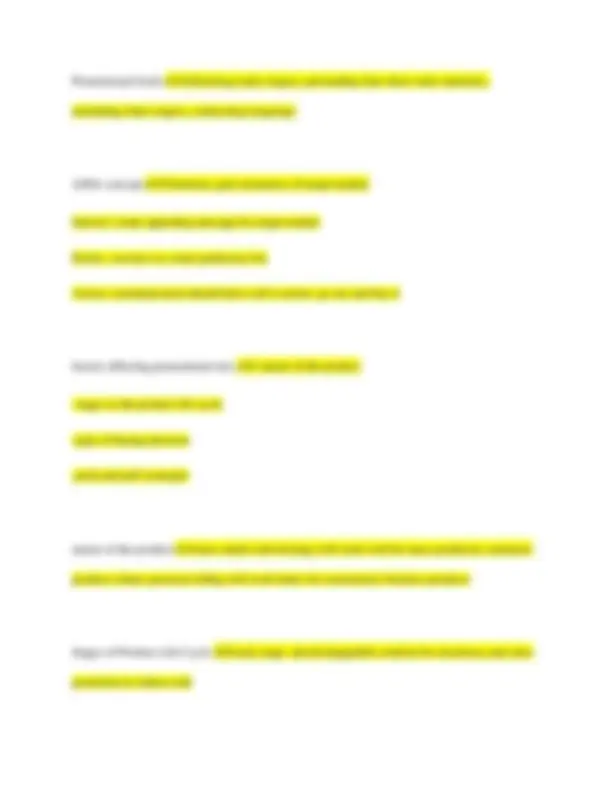
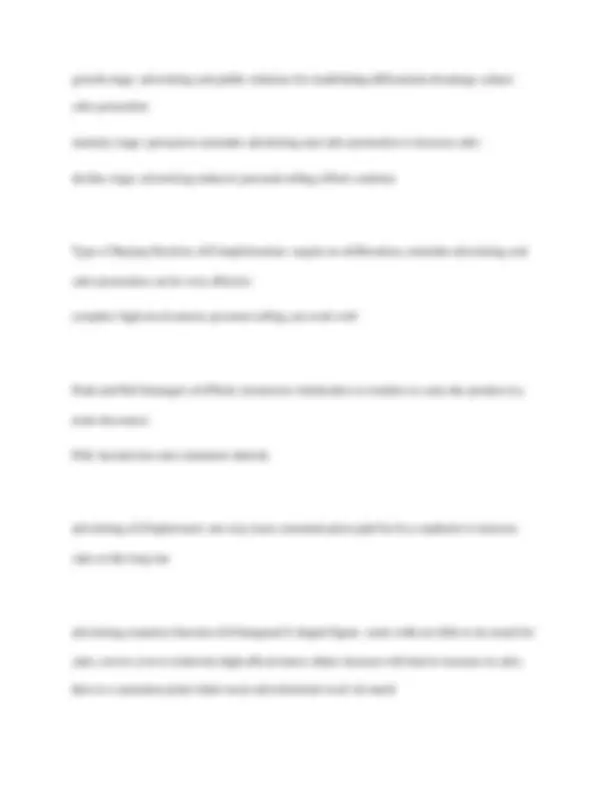
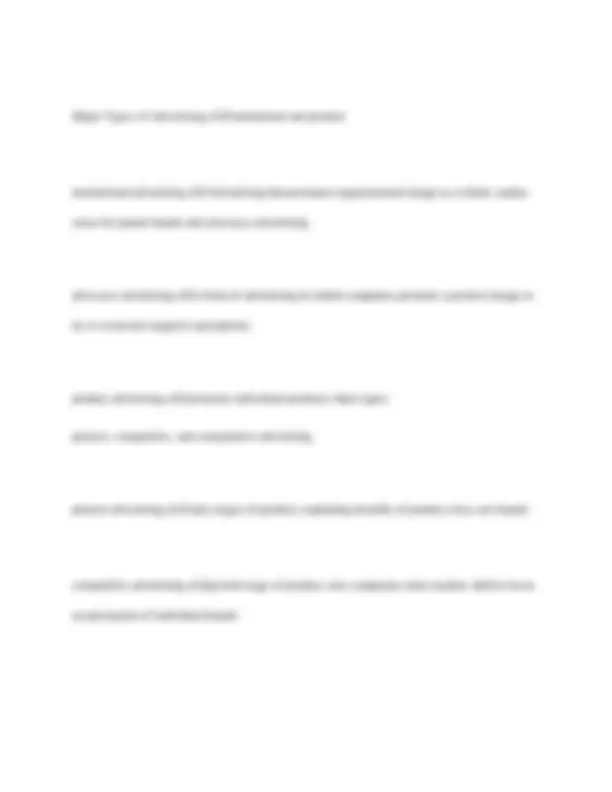
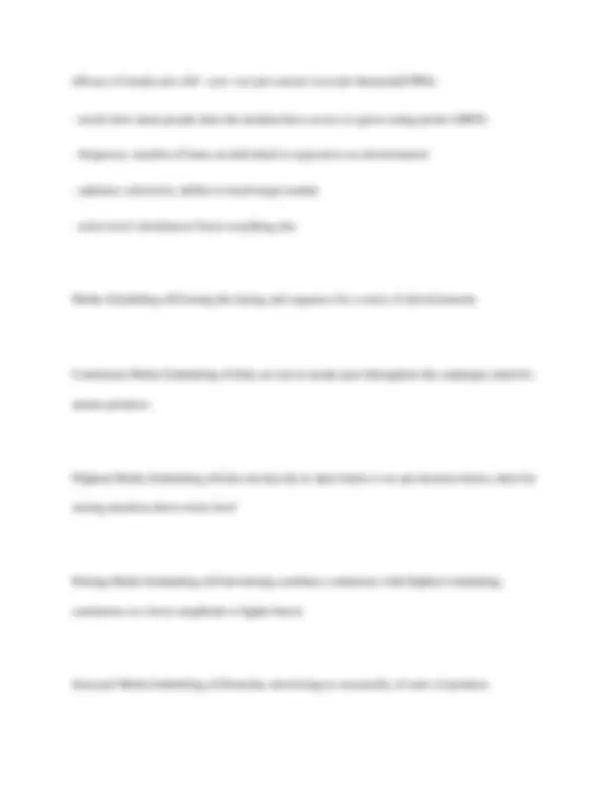
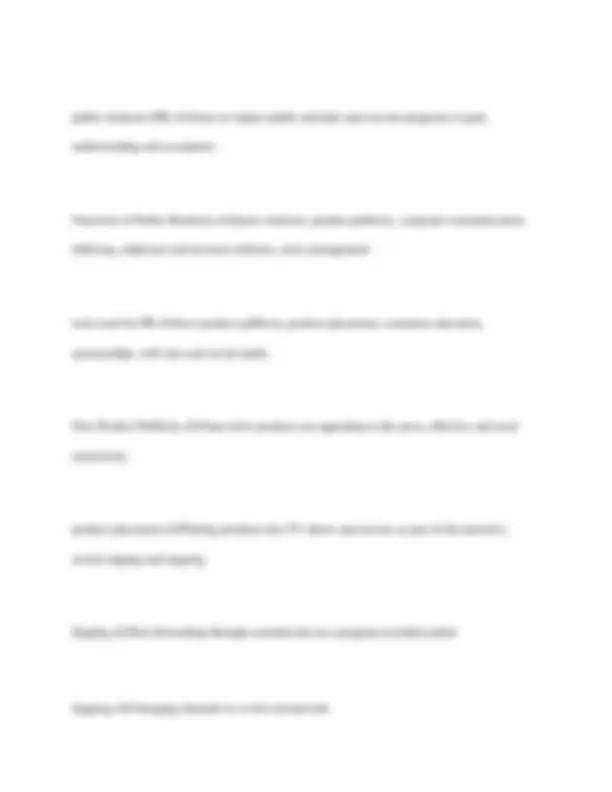
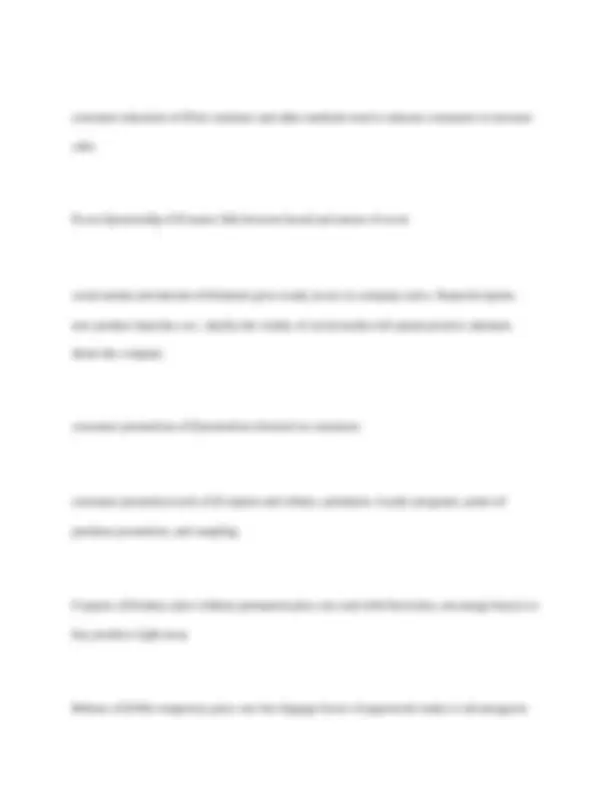
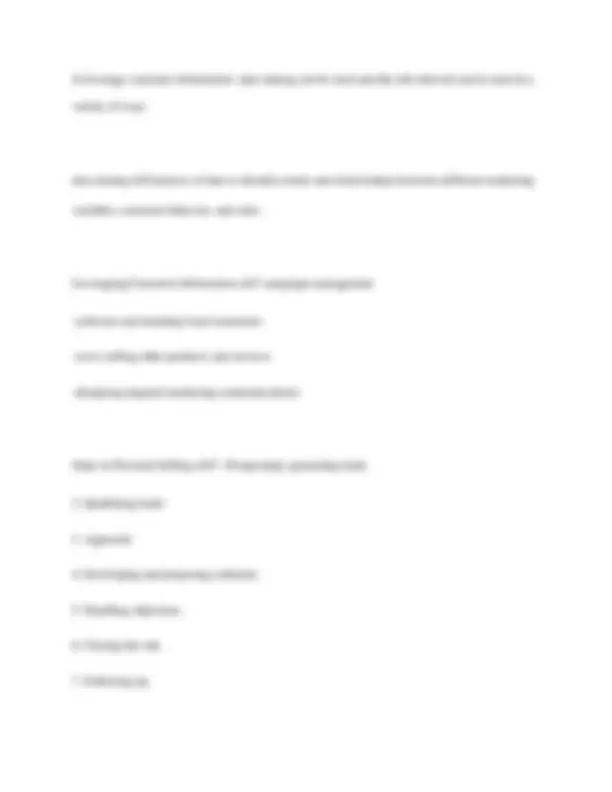
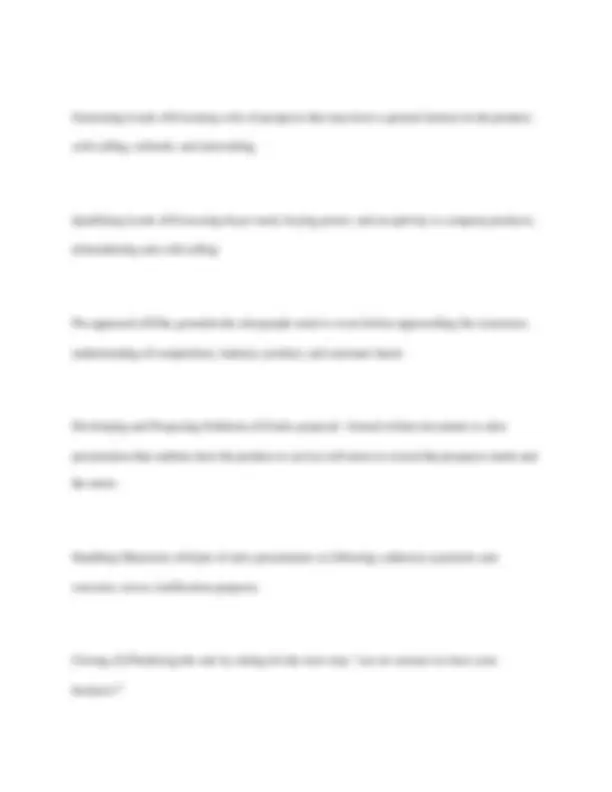
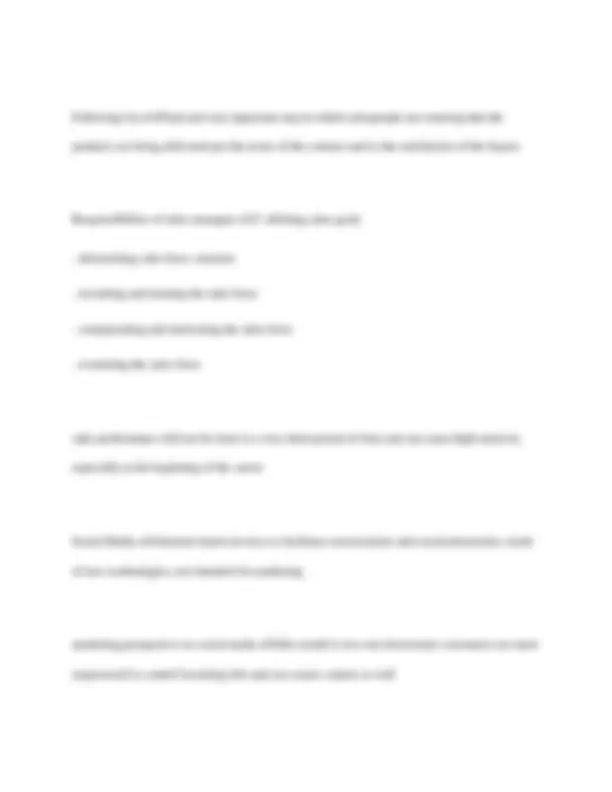
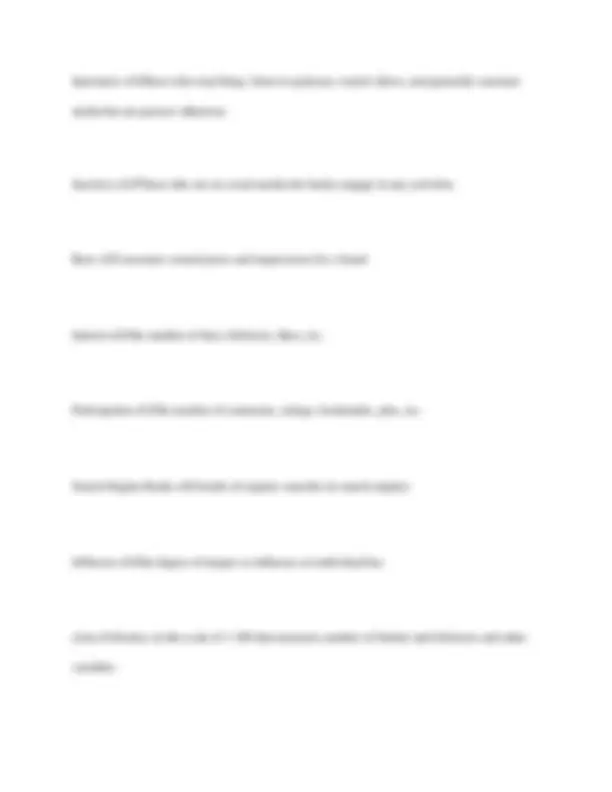
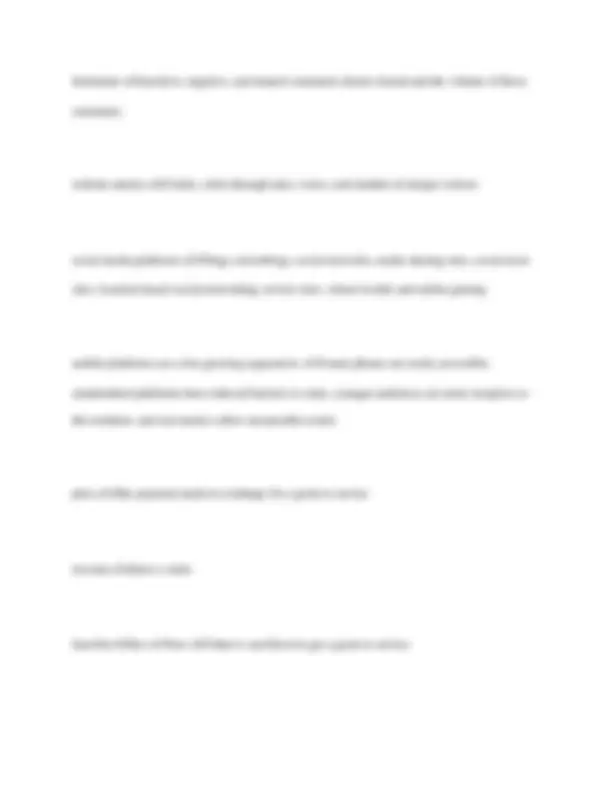

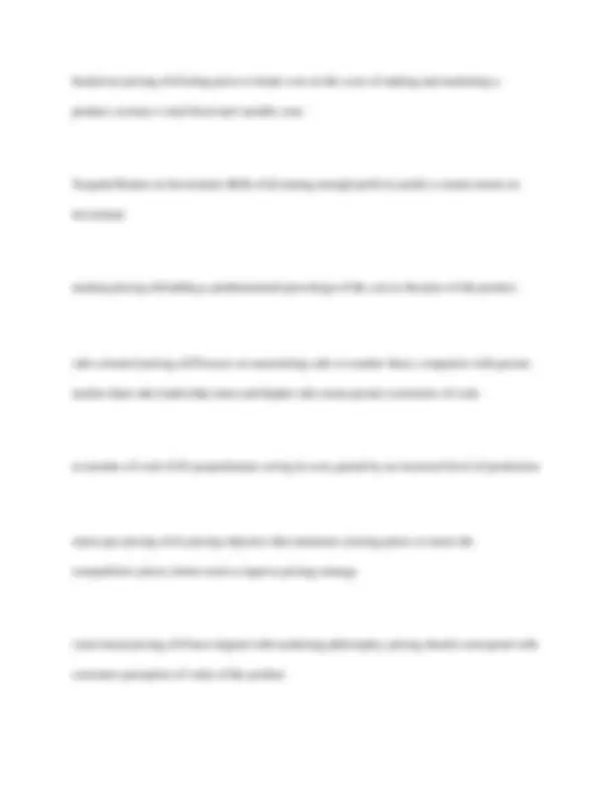
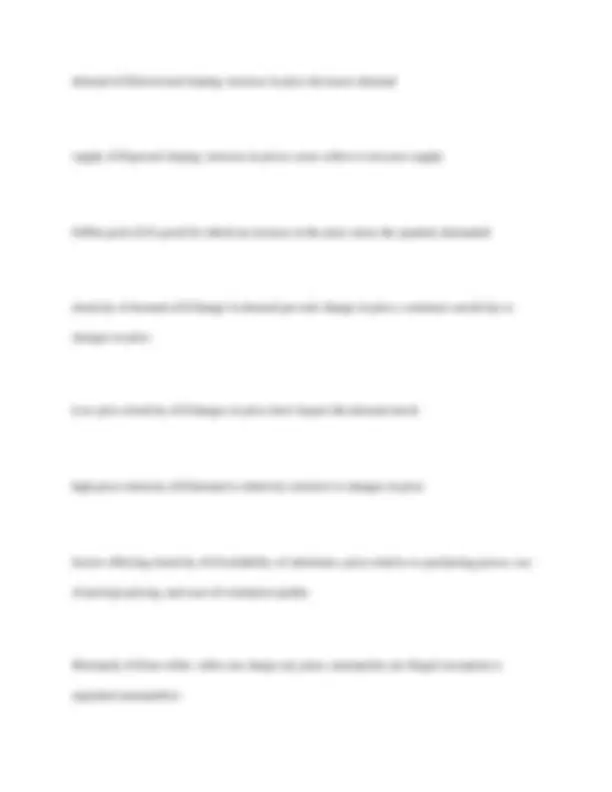
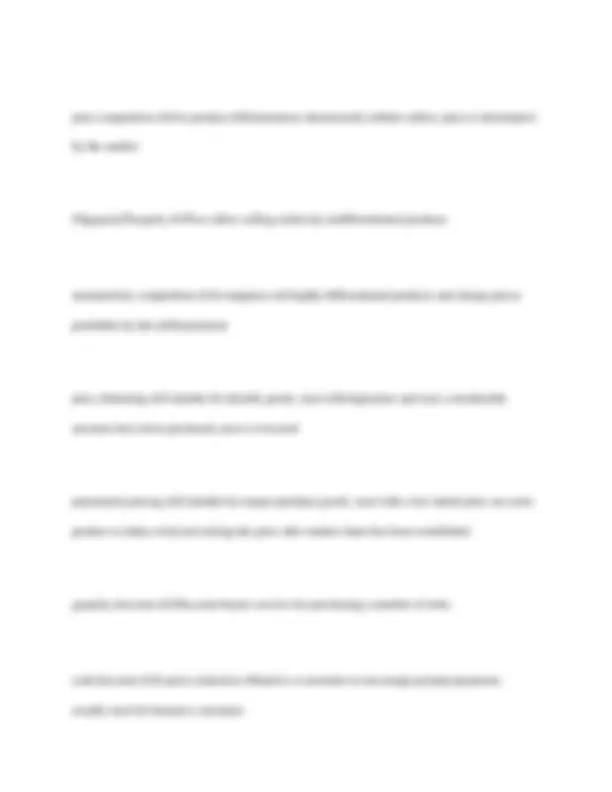
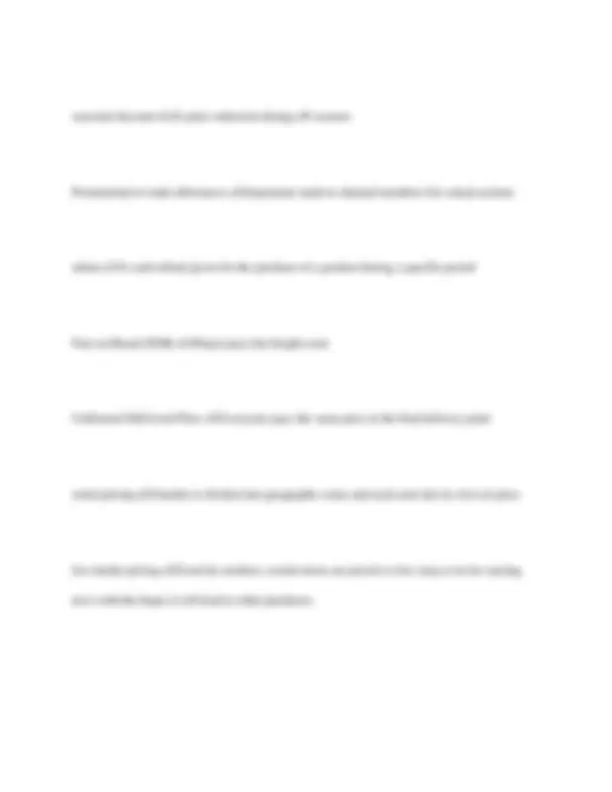


Study with the several resources on Docsity

Earn points by helping other students or get them with a premium plan


Prepare for your exams
Study with the several resources on Docsity

Earn points to download
Earn points by helping other students or get them with a premium plan
Community
Ask the community for help and clear up your study doubts
Discover the best universities in your country according to Docsity users
Free resources
Download our free guides on studying techniques, anxiety management strategies, and thesis advice from Docsity tutors
A comprehensive review of the promotional mix, covering key concepts like advertising, public relations, sales promotion, personal selling, and social media. It delves into the stages of the product life cycle, different types of advertising, and media planning strategies. The document also explores the role of public relations, consumer promotions, and personal selling in marketing.
Typology: Exams
1 / 24

This page cannot be seen from the preview
Don't miss anything!

















Promotional Mix ✔✔1) advertising
public relations
sales promotions
personal selling
social media
promotion ✔✔Communication by marketers that informs, persuades, and reminds potential buyers of a product in order to influence an opinion or elicit a response
promotional strategy ✔✔a plan for the optimal use of the elements of promotion to elicit a particular response; main goal is to convince buyers that the products offer competitive advantage
advertising ✔✔mass communication, high control, relatively low cost per customer, low credibility
public relations ✔✔unpaid, effective, limited control, higher credibility
sales promotion ✔✔all non-advertising and public relations activities that focus on promoting sales; typically short-term although may have spillover long-term effect; intended to induce product trial and additional sales
personal selling ✔✔in-person selling, more costly; more effective; works well for high cost items; aimed to inform and influence customers
social media ✔✔recent addition to promotional mix, shift of control of communication efforts to consumers
Integrated Marketing Communications (IMC) ✔✔aims to align all elements of the promotional mix for the best possible results
marketing communication ✔✔the process by which marketers impress on the buyers the value that their products have to offer
growth stage: advertising and public relations for establishing differential advantage, reduce sales promotion
maturity stage: persuasive reminder advertising and sales promotion to increase sales
decline stage: advertising reduced, personal selling efforts continue
Type of Buying Decision ✔✔simple/routine: require no deliberation, reminder advertising and sales promotion can be very effective
complex/ high involvement: personal selling can work well
Push and Pull Strategies ✔✔Push: incentivize wholesalers or retailers to carry the product (ex. trade discounts)
Pull: incentivizes end consumers directly
advertising ✔✔impersonal, one-way mass communication paid for by a marketer to increase sales in the long run
advertising response function ✔✔elongated S shaped figure- starts with too little to do much for sales, moves over to relatively high effectiveness where increase will lead to increase in sales, then to a saturation point where more advertisement won't do much
Major Types of Advertising ✔✔institutional and product
institutional advertising ✔✔Advertising that promotes organizational image as a whole; makes sense for parent brands and advocacy advertising
advocacy advertising ✔✔a form of advertising in which companies promote a positive image or try to overcome negative perceptions
product advertising ✔✔promotes individual products; three types:
pioneer, competitive, and comparative advertising
pioneer advertising ✔✔early stages of product; explaining benefits of product class, not brands
competitive advertising ✔✔growth stage of product; new companies enter market; shift to focus on persuasion of individual brands
executing the message by moving consumers through the AIDA process (through slice of life, testimonials, humor, science, etc.)
evaluation of the campaign
unique selling proposition (USP) ✔✔something that is special about the brand and emphasized on an ongoing basis; advertising appeal becomes USP
Media Decisions in Advertising ✔✔media type, media mix, and media schedule (collectively called media planning)
Media Types ✔✔- newspapers: cheap, geographically selective
media mix ✔✔emphasis placed on media outlets used, and the budget allocated to each
efficacy of media mix ✔✔- cost: cost per contact (cost per thousand(CPM))
Media Scheduling ✔✔setting the timing and sequence for a series of advertisements
Continuous Media Scheduling ✔✔ads are run at steady pace throughout the campaign; ideal for mature products
Flighted Media Scheduling ✔✔ads run heavily in short bursts w no ads between bursts; ideal for raising attention above noise level
Pulsing Media Scheduling ✔✔advertising combines continuous with flighted scheduling; continuous at a lower amplitude w higher bursts
Seasonal Media Scheduling ✔✔matches advertising to seasonality of sales of products
consumer education ✔✔free seminars and other methods used to educate consumers to increase sales
Event Sponsorship ✔✔creates link between brand and nature of event
social media and internet ✔✔internet gives ready access to company news, financial reports, new product launches, etc.; ideally the vitality of social media will spread positive attention about the company
consumer promotions ✔✔promotions directed at consumers
consumer promotion tools ✔✔coupons and rebates, premiums, loyalty programs, point-of- purchase promotion, and sampling
Coupons ✔✔reduce price without permanent price cuts and with fixed time, encourage buyers to buy products right away
Rebates ✔✔offer temporary price cuts but slippage factor of paperwork makes it advantageous
Premiums ✔✔extra items offered as incentives for purchase of original items
Loyalty Programs ✔✔reward customers based on the amount of business they conduct with the business
point of purchase (including sampling and displays) ✔✔promotion done at location; effective where consumers make their mind up in store
trade promotion ✔✔promotions directed at intermediaries like wholesalers, retailers, and distributors
trade allowance ✔✔a price reduction offered to intermediaries in exchange for something; ex.) extra shelf space
push money ✔✔a bonus given by manufacturers to salespeople for pushing heir product; beneficial when manufacturers adopt push strategies
training ✔✔effective when the product is complex
data mining ✔✔analysis of data to identify trends and relationships between different marketing variables, customer behavior, and sales
Leveraging Customer Information ✔✔-campaign management
-cultivate and retaining loyal customers
-cross-selling other products and services
-designing targeted marketing communications
Steps in Personal Selling ✔✔1. Prospecting/ generating leads
Generating Leads ✔✔creating a list of prospects that may have a general interest in the product; cold calling, referrals, and networking
Qualifying Leads ✔✔assessing buyer need, buying power, and receptivity to company products; telemarketing and cold calling
Pre-approach ✔✔the groundwork salespeople need to cover before approaching the customers; understanding of competition, industry, product, and customer intent
Developing and Proposing Solutions ✔✔sales proposal - formal written document or sales presentation that outlines how the product or service will meet or exceed the prospects needs and the terms
Handling Objections ✔✔part of sales presentation or following; addresses questions and concerns; serves clarification purposes
Closing ✔✔finalizing the sale by asking for the next step: "can we assume we have your business?"
Crowdsourcing ✔✔use consumers to create new marketing initiatives and improve existing ones
Categories of Media ✔✔owed, earned, and paid
Owed Media ✔✔content that an organization creates and controls for the most part
Earned Media ✔✔all other coverage and online buzz about the brand earned through word of mouth
Paid Media ✔✔similar to advertising; ex.) display ads and Google AdWords
Leveraging Social Media ✔✔- listening and learning
Social Media Plan ✔✔1. Listen
Levels of Social Media Engagement ✔✔creators, critics, collectors, joiners, spectators, and inactives
Creators ✔✔Those who produce and share online content like blogs, Web sites, articles, and videos
Critics ✔✔Those who post opinions, comments, ratings, and reviews of products
Collectors ✔✔Those who actively collect data and vote for websites
Joiners ✔✔Those who maintain a social networking profile on various sites
Sentiment ✔✔positive, negative, and neutral comments about a brand and the volume of those comments
website metrics ✔✔clicks, click-through rates, views, and number of unique visitors
social media platforms ✔✔blogs, microblogs, social networks, media sharing sites, social news sites, location-based social networking, review sites, virtual worlds and online gaming
mobile platforms are a fast growing segment bc ✔✔smart phones are easily accessible, standardized platforms have reduced barriers to entry, younger audiences are more receptive to this medium, and real metrics allow measurable results
price ✔✔the payment made in exchange for a good or service
revenue ✔✔price x units
Sacrifice Effect of Price ✔✔what is sacrificed to get a good or service
reward effect of price ✔✔what is gain in return
perceived value ✔✔the difference between reward and sacrifice effects of price
profit ✔✔revenue - cost
variable cost ✔✔total variable cost varies based on units but the unit variable cost stays the same
fixed cost ✔✔total fixed cost remains the same regardless of number of units but the per unit fixed cost is reduced with each additional unit
profit oriented pricing ✔✔- profit maximization
profit maximization ✔✔setting profits to be maximized- reduce costs and increase revenue